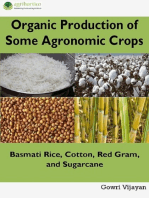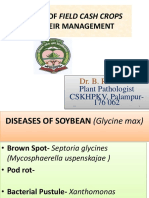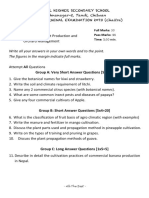Micrografting
Micrografting
Uploaded by
DrRuby Ranjan SharmaCopyright:
Available Formats
Micrografting
Micrografting
Uploaded by
DrRuby Ranjan SharmaOriginal Description:
Copyright
Available Formats
Share this document
Did you find this document useful?
Is this content inappropriate?
Copyright:
Available Formats
Micrografting
Micrografting
Uploaded by
DrRuby Ranjan SharmaCopyright:
Available Formats
Micrografting (shoot tip grafting)
• The term micro grafting means the grafting of meristamatic tissues in vitro in the laboratory in
which the shoots of one plant are grafted on to the shoots or roots of another plant so as to
combine the characteristics of the two plants.
This method was used for the first time in 1952 by Morel and Martin . Micrografting was
initially used on vegetables. The success rate of micrografting is relatively high (80– 90%) for
tomatoes.
Micrografting consists of the placement in aseptic conditions of a maintained scion onto an in
vitro grown rootstock.
• The results of in vitro micrografting and the plant material derived from it can be further
multiplied in tissue culture conditions or acclimatized to outdoor conditions.
• Micrografting is a technique that potentially can combine the advantages of rapid in vitro
multiplication with increased productivity that results from grafting, superior rootstock and scion
combinations
. • Among various methods of micrografting, slit or wedge grafting has been found most suitable
in case of fruit crops.
• In vitro shoot tips are better as compared to in vivo shoot tips for carrying out micrografting
resulting in higher graft success, less contamination, lower shoot tip necrosis and good vigour of
micrografts.
This comprises the following steps
• Aseptic condition was maintained throughout all stages of micrografting process.
• Seedlings were removed carefully from the agar medium with sterilized forceps.
• For use as rootstock, seedlings were cut back to 1 cm above the cotyledonary nodes and leaves
were excised using a microscalpel.
• Terminal shoots to be used as scions were excised from the other seedlings at 2 cm below the
apex. • Lower leaves removed from the basal 1 cm of scion.
• Excised scion and rootstocks were stored in sterile de-ionized water until used in the grafting
process.
The shoot tip was inserted at the top of decapitated rootstock by making an incision.
• The cortex was exposed by the horizontal cut of the incision.
• Grafted plants were cultured in a liquid nutrient medium containing plant cell culture salt
solution of MS, modified White's vitamins and 75 g/1 sucrose.
• When at least two expanded leaves were formed micrografted plants were transferred to pots
containing a steam sterilized soil mixture suitable for plant.
Importance
• Overcoming graft incompatibility
• Rapid mass propagation of elite scions by grafting onto rootstocks that have desirable traits like
resistance to soil borne pathogens and diseases
• To allow survival of difficult to root /shoots
• Development of virus free plant
You might also like
- Black Pepper Cultivation-EswarDocument69 pagesBlack Pepper Cultivation-EswarDr.Eswara Reddy Siddareddy100% (1)
- Ele Hort 367 Notes - 240214 - 214415Document50 pagesEle Hort 367 Notes - 240214 - 214415vishalpawar1220No ratings yet
- Hitech HorticultureDocument7 pagesHitech HorticultureSuganthan SivaNo ratings yet
- China Aster 336Document9 pagesChina Aster 336Manish M. RamaniNo ratings yet
- Production Technology For Ornamental Crops, Maps and LandscapingDocument26 pagesProduction Technology For Ornamental Crops, Maps and LandscapingDr. Praveen SinghNo ratings yet
- Production Technology of ZantedeschiaDocument60 pagesProduction Technology of Zantedeschiaannappurna83% (6)
- Disease of Ornamental CropsDocument19 pagesDisease of Ornamental CropsPooja Bhusal100% (1)
- Grapes Production EswarDocument36 pagesGrapes Production EswarDr.Eswara Reddy SiddareddyNo ratings yet
- Seminar On INFLUENCE OF PRE-HARVEST FACTORS ON POST HARVEST HANDLING OF FLORICULTURAL CROPsDocument68 pagesSeminar On INFLUENCE OF PRE-HARVEST FACTORS ON POST HARVEST HANDLING OF FLORICULTURAL CROPsAnand Singh RawatNo ratings yet
- Seed Technology 312Document414 pagesSeed Technology 312shiva kumar goud100% (1)
- Producation Technology of CapsicumDocument40 pagesProducation Technology of CapsicumPravinNo ratings yet
- MCQ Objective OlericultureDocument7 pagesMCQ Objective OlericultureurmilaNo ratings yet
- Hort - 355 ManualDocument47 pagesHort - 355 ManualKaran NawaleNo ratings yet
- Rose Protected CultivationDocument25 pagesRose Protected CultivationDheeran NarendiranNo ratings yet
- Causes and Control of Unfruitfulness in Fruit CropsDocument29 pagesCauses and Control of Unfruitfulness in Fruit CropsDr. Govind VishwakarmaNo ratings yet
- Vegetable Based Cropping SystemDocument4 pagesVegetable Based Cropping SystemRubi100% (1)
- OrchidsDocument11 pagesOrchidsAnduk Guemera100% (1)
- Production and Marketing of Quality Planting Material: Hands-On-Training/experiential LearningDocument30 pagesProduction and Marketing of Quality Planting Material: Hands-On-Training/experiential LearningKanchanNo ratings yet
- 07042020124050lecture Notes of Renewable Energy and Green TechnologyDocument108 pages07042020124050lecture Notes of Renewable Energy and Green TechnologyMinhaj GhouriNo ratings yet
- Varieties of Betel Vine and SupportsDocument4 pagesVarieties of Betel Vine and SupportsDr.Eswara Reddy SiddareddyNo ratings yet
- Chapter 1 FinalDocument50 pagesChapter 1 FinalJr AquinoNo ratings yet
- Crop Production Technology - Kharif CropsDocument32 pagesCrop Production Technology - Kharif CropsAKSHAY THOTTUVANo ratings yet
- CarnationDocument23 pagesCarnationMANDIRA PRADHANNo ratings yet
- Extension Folder No-67-Arecanut Fruit RotDocument2 pagesExtension Folder No-67-Arecanut Fruit RotAsh1ScribdNo ratings yet
- Know The Difference Between Training and Pruning of Fuit CropsDocument3 pagesKnow The Difference Between Training and Pruning of Fuit CropsDr.Eswara Reddy SiddareddyNo ratings yet
- Ele Hort 368 Full Printed Notes PDFDocument48 pagesEle Hort 368 Full Printed Notes PDFrushikesh KanireNo ratings yet
- Hort 221Document90 pagesHort 221Voice AnonymousNo ratings yet
- Problematic SoilsDocument45 pagesProblematic SoilsSimta Sharma100% (1)
- GPB-243 Theory NotesDocument86 pagesGPB-243 Theory NotesRushikesh Kshirsagar100% (1)
- Canopy Management in FruitsDocument4 pagesCanopy Management in FruitsjdmanishkapoorNo ratings yet
- Seed TechnologyDocument5 pagesSeed TechnologyNILESH KUMAR SINGH100% (1)
- AGS 322 Diseases of Field Crops and Their ManagementDocument54 pagesAGS 322 Diseases of Field Crops and Their ManagementNavneet KumarNo ratings yet
- 3 Plant Protection II PDFDocument129 pages3 Plant Protection II PDFAvijitSinharoyNo ratings yet
- 7.TOMATO PPT - 0Document22 pages7.TOMATO PPT - 0Senthil MuruganNo ratings yet
- Dryland Agriculture: 1. Dry FarmingDocument17 pagesDryland Agriculture: 1. Dry Farmingashok kumar singhNo ratings yet
- Pumpkin PDFDocument5 pagesPumpkin PDFm_k_navghare4041No ratings yet
- Cultivation of Rice in IndiaDocument65 pagesCultivation of Rice in IndiarishabhNo ratings yet
- Wasteland ReclamationDocument4 pagesWasteland ReclamationABHAS KUMAR0% (1)
- Growing MediaDocument19 pagesGrowing MediaRonald CortezanoNo ratings yet
- Hort 232 Practical ExamDocument1 pageHort 232 Practical ExamVikki Nandeshwar100% (1)
- Rapeseed and Mustard PDFDocument10 pagesRapeseed and Mustard PDFLucky TraderNo ratings yet
- Botanical Classification of VegetablesDocument4 pagesBotanical Classification of Vegetablesusha rani VeeraNo ratings yet
- Plpath233 IV Diseases of Field Crops and Their ManagementDocument75 pagesPlpath233 IV Diseases of Field Crops and Their ManagementManjeet DhNo ratings yet
- Grade: XI Subject: Commercial Fruit Production andDocument2 pagesGrade: XI Subject: Commercial Fruit Production andNishad MallaNo ratings yet
- Seed SelectionDocument13 pagesSeed SelectionDen Mark Tuazon RañolaNo ratings yet
- CitrusDocument100 pagesCitrusDac100% (1)
- Juvenility Flower Bud DifferentationDocument7 pagesJuvenility Flower Bud Differentationtopicwise solution50% (2)
- Propagation Techniques in PepperDocument4 pagesPropagation Techniques in PepperDr.Eswara Reddy Siddareddy100% (1)
- Integrated Pest Manage Ment of Flower Crops UnderDocument158 pagesIntegrated Pest Manage Ment of Flower Crops Undervijjumandula100% (1)
- PPT-5 Principles of Pruning and Systems of Training of Fruit PlantsDocument31 pagesPPT-5 Principles of Pruning and Systems of Training of Fruit Plantsafrin2301101025No ratings yet
- HYBRIDIZATIONDocument22 pagesHYBRIDIZATIONPoshan Shah ThakuriNo ratings yet
- Chickpea: Vulgaris) and Dry Peas (Pisum Sativum L.) - Chickpea Seeds Contain On Average 18-22% ProteinDocument7 pagesChickpea: Vulgaris) and Dry Peas (Pisum Sativum L.) - Chickpea Seeds Contain On Average 18-22% ProteinGanpat Lal SharmaNo ratings yet
- SEED Study Materiyal-1Document24 pagesSEED Study Materiyal-1Sridhar Sridhar100% (1)
- Diseases of Horticultural Crops and Their ManagementDocument90 pagesDiseases of Horticultural Crops and Their Managementnormanwillow67% (3)
- Canopy Management in AppleDocument20 pagesCanopy Management in AppleAbhishekpNo ratings yet
- N Ntroduction: Principles of Crop Protection Principles of Crop ProtectionDocument31 pagesN Ntroduction: Principles of Crop Protection Principles of Crop ProtectionMaylynn ToloNo ratings yet
- Cropping Systems in Vegetables: R.P. Singh, Padmaja Pande, S.S. Solankey and Antra ChatterjeeDocument27 pagesCropping Systems in Vegetables: R.P. Singh, Padmaja Pande, S.S. Solankey and Antra ChatterjeeBasiru IbrahimNo ratings yet
- Ilium Cut Flower: Production UnderDocument2 pagesIlium Cut Flower: Production UnderDrRuby Ranjan SharmaNo ratings yet
- Temple Waste Utilization and Management: A Review: Isha Yadav, Shelja K. Juneja and Sunita ChauhanDocument6 pagesTemple Waste Utilization and Management: A Review: Isha Yadav, Shelja K. Juneja and Sunita ChauhanDrRuby Ranjan SharmaNo ratings yet
- Cutting PropagationDocument31 pagesCutting PropagationDrRuby Ranjan SharmaNo ratings yet
- Advantages and Disadvantages of Sexual and Asexual PropagationDocument4 pagesAdvantages and Disadvantages of Sexual and Asexual PropagationDrRuby Ranjan Sharma100% (3)
- By-Assma Parveen Roll No. 11-AMJ-01 Deptt of ABTDocument8 pagesBy-Assma Parveen Roll No. 11-AMJ-01 Deptt of ABTDrRuby Ranjan SharmaNo ratings yet
- Floriculture Today: March 2013Document70 pagesFloriculture Today: March 2013udaykumar300No ratings yet
- Orchidsforeveryo00curt PDFDocument444 pagesOrchidsforeveryo00curt PDFDrRuby Ranjan SharmaNo ratings yet
- Marigold VarietiesDocument1 pageMarigold VarietiesDrRuby Ranjan SharmaNo ratings yet
- 602 Cover PageDocument1 page602 Cover PageDrRuby Ranjan SharmaNo ratings yet
- Thesis ReferenceDocument16 pagesThesis ReferenceDrRuby Ranjan SharmaNo ratings yet
- Nature of LigtDocument3 pagesNature of LigtDrRuby Ranjan SharmaNo ratings yet
- 20.orchid Molecular BreedingDocument23 pages20.orchid Molecular BreedingDrRuby Ranjan SharmaNo ratings yet
- VPE VPE VPE VPE VPE VPE: No. of Nodes Responded For EstablishmentDocument3 pagesVPE VPE VPE VPE VPE VPE: No. of Nodes Responded For EstablishmentDrRuby Ranjan SharmaNo ratings yet
- Department of Plant Pathology, Faculty of Agriculture Assam Agricultural University, Jorhat-13 Thesis Seminar Assessment Report Phd/M. SCDocument2 pagesDepartment of Plant Pathology, Faculty of Agriculture Assam Agricultural University, Jorhat-13 Thesis Seminar Assessment Report Phd/M. SCDrRuby Ranjan SharmaNo ratings yet
- Physiology of Flowering Plant Molecular LevelDocument59 pagesPhysiology of Flowering Plant Molecular LevelDrRuby Ranjan SharmaNo ratings yet
- Chloroplast: Chloroplast-The Site of PhotosynthesisDocument2 pagesChloroplast: Chloroplast-The Site of PhotosynthesisDrRuby Ranjan SharmaNo ratings yet
- Department of Horticulture:: Assam Agricultural University JORHAT-13 NoticeDocument1 pageDepartment of Horticulture:: Assam Agricultural University JORHAT-13 NoticeDrRuby Ranjan SharmaNo ratings yet
- Trademark PGS 503Document12 pagesTrademark PGS 503DrRuby Ranjan SharmaNo ratings yet
- PGS 503 Topics Aug12Document1 pagePGS 503 Topics Aug12DrRuby Ranjan SharmaNo ratings yet
- Nematicidal Activity of Plant Extracts Against The Root-Knot Nematode, Meloidogyne IncognitaDocument1 pageNematicidal Activity of Plant Extracts Against The Root-Knot Nematode, Meloidogyne IncognitaDrRuby Ranjan SharmaNo ratings yet
- Plant Tissue Culture. Techno-Commercial FeasibilityDocument39 pagesPlant Tissue Culture. Techno-Commercial Feasibilityeverboleh100% (5)
- Ruby Seminar AbstrDocument2 pagesRuby Seminar AbstrDrRuby Ranjan SharmaNo ratings yet

















































































